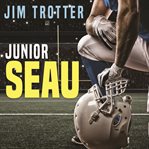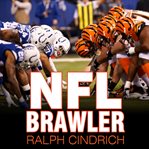Review by Booklist Review
In January 2015, linebacker Junior Seau was voted into the Pro Football Hall of Fame. He did not attend the ceremony. Seau committed suicide in 2012 at age 43. Later, studies of his brain revealed he was suffering from chronic traumatic encephalopathy (CTE). It's very likely that his condition contributed to his suicide, but there's no doubt it brought a laser focus to the issue of brain damage as a result of playing football. Trotter, who covers the NFL for ESPN, tells a difficult story and tells it well. In addition to the challenge of writing about a young man's suicide without becoming maudlin, Trotter had to overcome trust issues with different branches of Seau's family who were estranged from one another. Complicating matters further was Seau himself: adored by the public but dealing with both alcohol and family troubles at the time of his suicide. While acknowledging that it is impossible to know for sure if CTE exacerbated Seau's personal issues, Trotter makes a strong case that the condition can alter behavior in ways not yet fully understood. This is a powerful, thought-provoking account, handled with grace and sensitivity, of a superior football player's life and death.--Lukowsky, Wes Copyright 2015 Booklist
From Booklist, Copyright (c) American Library Association. Used with permission.
Review by Publisher's Weekly Review
Despite the significant concussion discussion that ensued following the suicide of Junior Seau, a 2015 Pro Football Hall of Fame inductee, the first posthumous biography of the athlete notably lacks details on head injuries. The former linebacker committed suicide in 2012 at the age of 43; his family later sued the National Football League, alleging that the NFL concealed from players the dangers of football-related brain trauma. ESPN football writer Trotter, who covered Seau's career and developed a professional and personal relationship with him, states that Seau, who played 268 NFL games over 20 seasons, was not once diagnosed with a concussion. Seau, born Tiaina Baul Seau Jr., grew up poor in San Diego County, Calif., and spent the majority of his NFL years with the hometown Chargers. He was universally considered one of the league's nicest guys. But a series of poor post-retirement business decisions, excessive partying and addictions, and a self-perceived inability to love others set Seau on a path of destruction that ultimately led to his demise. Trotter interviewed many of Seau's family members and friends, who here break their silence for the first time since his death. He also extensively quotes former NFL teammate Rodney Harrison, who blames a small group of enablers for not encouraging Seau to seek help when he needed it most. (Oct.) © Copyright PWxyz, LLC. All rights reserved.
(c) Copyright PWxyz, LLC. All rights reserved
Review by Library Journal Review
Trotter, a popular NFL reporter for ESPN and Sports Illustrated, began his career writing for the San Diego Union-Tribune, where he got to know San Diego Chargers linebacker Junior Seau (1969-2012) while serving as a beat writer for the Chargers. Seau experienced a tragic life. Perhaps the greatest linebacker of his generation, he was a hard-working team player with a buoyant personality who was loved and respected by both teammates and opponents throughout his 20-year NFL career. However, his life had a dark side. So much of his identity was tied to football that one coach presciently remarked early in Seau's career, "It's not going to end well for this guy." As the years went on, the problems grew: drinking, gambling, womanizing, poor investing, and the physical toll of playing professional football. Trotter, utilizing his relationship with Seau, interviewed family, friends, teammates, coaches, ex-wives, former girlfriends, and even the athlete's children. What emerges is a sensitive, honest portrayal of a man in crisis who could see no way out of his worldly problems except suicide. VERDICT This frank biography of a football hero should appeal to a wide audience. John Maxymuk is Head of Public Services at Rutgers University's Paul Robeson Library, Camden, NJ. He is a longtime sports reviewer for LJ and the author of NFL Head Coaches: A Biographical Dictionary, ~ 1920-2011 (McFarland, 2012) © Copyright 2015. Library Journals LLC, a wholly owned subsidiary of Media Source, Inc. No redistribution permitted.
(c) Copyright Library Journals LLC, a wholly owned subsidiary of Media Source, Inc. No redistribution permitted.
Review by Kirkus Book Review
ESPN NFL reporter Trotter debuts with a very sympathetic account of the life of NFL Hall of Fame linebacker Junior Seau (1969-2012). The author has few negative things to say in this highly conventional biographyeven the linebacker's arrest for domestic abuse in 2010 receives a walking-on-eggshells treatment. The author begins by observing, "we don't really know our athletic heroes," and proceeds to show us many of Seau's hidden facets, although a number of key individuals (his partying buddies) declined to be interviewed. Trotter gives us details about Seau's Samoan heritage and then takes us through his school days (with a 3.6 academic average in high school, he could not manage a decent score on the SAT), his athletic dominance at all levels, his ferocious work ethic, and his determination to play with pain. We also learn about his family lifewomanizing, partying, and gambling eventually caused numerous estrangementsand his financial collapse after he retired. Trotter shows us a player honored by his high school, college, and pro teammates, coaches, and fans. He was deeply respected not just for his athletic gifts, but also for his sense of humor and his leadership. The author doesn't give too many detailed accounts of gamesjust key plays and moments. He also pauses occasionally to expatiate on head injuries, alcoholism, drug use, and, of course, evanescent fame. Unfortunately, the author falls victim too often to clich ("Fear was not in his vocabulary"; "he won her heart with his kindness"; "His star could not have been brighter"). Deeply invested in Seau's sad story, Trotter also overstates the effect of his suicide in 2012, observing that sadness swept the land. Although the text benefits from the author's deep knowledge of the gameand from many important interviewsexcessive sentiment corrodes. Copyright Kirkus Reviews, used with permission.
Copyright (c) Kirkus Reviews, used with permission.


